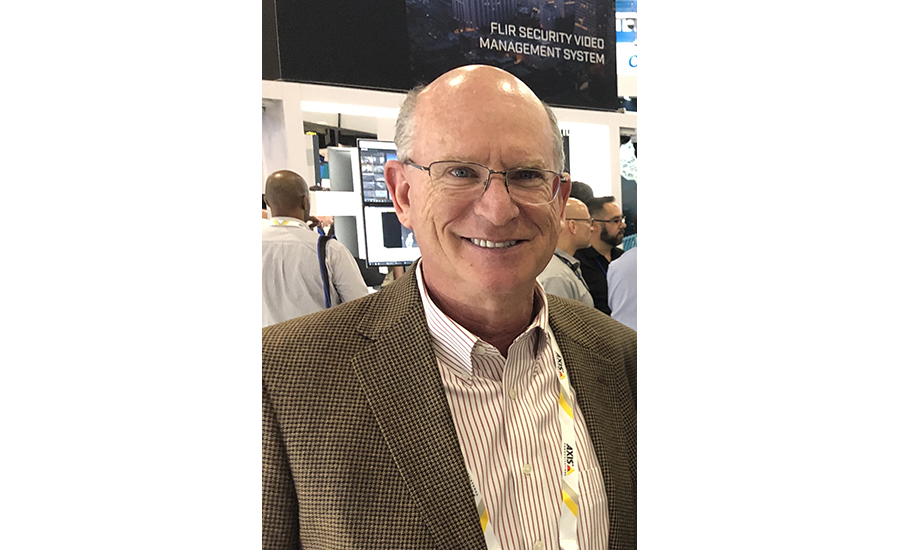THE NEED FOR VIDEO MANAGEMENT SOFTWARE (VMS) when deploying surveillance systems isn’t a new one — a variety of manufacturers have been pushing different offerings out for years now. But like many aspects of the security industry (and the world), the COVID-19 pandemic has certainly increased the need for an efficient way to manage video, as business owners are keeping an eye on things from home. VMS has also grown in popularity due to its capabilities surrounding data collection, which can be used for contact tracing, temperature scanning, social distancing and more.
For security systems integrators, all of these new capabilities and use cases can be daunting. Here, SDM spoke with five integrators who are succeeding with VMS: Paul Allyn, president of Justice Systems, Auburn, Wash.; Jared Tyser, vice president of sales, Sound Solutions, Mexico, Mo.; Brent Fink, senior account manager, Delta Wireless Inc., Stockton, Calif.; Randall Renfroe, president, Allstate Security, Amarillo, Texas; and Daved Levine, owner and president, SCI Inc., Albuquerque, N.M. Read on for advice on how to become well versed in VMS.
SDM: What has been your most challenging project involving VMS? How did you successfully complete it?

Paul Allyn, president of Justice Systems, Auburn, Wash.
ALLYN: Co-integrating with a countywide area network to centralize servers and storage for three separate, geographically dispersed jail facilities, while providing a “virtual matrix” stream switching latency at the clients’ facility of less than one second. We first piloted the concept together with county IT and made performance measurements. However, when scaled and running on the actual facility LAN, performance lagged. Ultimately, a network bottleneck was removed at the county data center and with VMS and network settings sufficiently optimized and coordinated, that performance of approximately one second was achieved.

Jared Tyser, vice president of sales, Sound Solutions, Mexico, Mo.
TYSER: A single project doesn’t come to mind, but in general, projects are more challenging when integrating numerous existing cameras into a new VMS. When working with existing cameras, you run into a variety of manufacturers. Using ONVIF helps for sure, but doesn’t guarantee a smooth integration. Gathering as much information as possible about the existing system (age, manufacturer, firmware versions, etc.) has helped us prepare for and estimate projects more accurately.

Brent Fink, senior account manager, Delta Wireless Inc., Stockton, Calif.
FINK: Most challenging for us would have to be surveillance on the fly — customers requesting surveillance for high-profile projects and people on short notice. Having a staff that can build, implement and monitor a reliable product virtually overnight is how we overcame that challenge.

Daved Levine, owner and president, SCI Inc., Albuquerque, N.M.
LEVINE: Providing a scalable, reliable and feature-rich solution for many local municipalities and having a single robust VMS architecture for archiver failover and redundancy.

Randall Renfroe, president, Allstate Security, Amarillo, Texas
RENFROE: Being both a full-service integrator and a full-service monitoring station for our organic and wholesale clients, narrowing down a singular project solution that brought some challenges is no easy task, as several have their own specific needs based on any existing infrastructure to integration to other in-house solutions and more. However, ASI provides a choice of VMS solutions across various platforms that work with many types of IP and analog cameras and also integrate with our central station software. Nominating just one singular VMS in our monitoring station and for our technical teams would limit us, so the problem came with how many we should have and how to become the best at them. We overcame the primary challenge first, which was choosing five VMS packages to meet our most commonly used projects, allowing our clients to scale up or down with both functionality and cost. We invested heavily in training, equipment and integration to make sure we could provide our client with choices.
Manufacturers’ Insights
SDM asked manufacturers what they wished integrators knew about their VMS solutions. Here’s what they had to say:
“Underutilization of its many functions is the biggest challenge with regard to our solution. It’s common for camera placement and video storage needs to be made clear during the scoping stage of the project, but additional functionality and complete capabilities of the VMS are often not fully vetted, and as a result, no labor is allocated in the implementation phase to cover these features. A feature such as mapping may be critically important to customers and additional functions, if known, can be used to transform their business. Salient’s robust, scalable VMS can be used for basic investigations all the way to 60,000+ camera enterprise systems spread across multiple sites around the globe.” — Paul Fisher, Vice President of Key and National Accounts, Salient Systems, Austin, Texas
“A VMS solution can now be the brains for network audio speakers, intercoms, access control and analytics. These additional devices can provide a holistic solution for both security and non-security related business challenges. For example, tying video, analytics and audio together, an end user can now proactively play a message that deters someone from going into a restricted area or from loitering outside a store after hours. End users can now also receive business intelligence and gain operational efficiencies through their video surveillance system. By adding analytics and audio, users can alert staff when a checkout gets too long and acquire data to identify foot traffic trends to staff their store accordingly.” — Mitch Mershon, Business Development Manager, End to End Solutions, Americas, Axis Communications, Chelmsford, Mass.
“[The] FLIR UVMS is completely scalable from installations ranging from a handful of cameras to those with more than 15,000 cameras and beyond. That scalability also extends to various third party devices and software. FLIR AIC (Applications & Integrations Center) is ready and willing to help with the integration of supporting technologies within UVMS to streamline workflows and allow multiple systems to work in concert together. Our local engineering support teams can also help solve complex challenges during initial integration and day-to-day operation.” — Kai Moncino, Business Development Manager, Industrial Technologies, FLIR Systems, Arlington, Va.
“We most wish for integrator partners to understand our solution’s full range of capabilities. … VIGIL is often viewed as a retail-centric solution because of our well-known success in the retail world, but we are quite prominent in many markets including education, manufacturing, multi-tenant and industrial. With the release of our latest version, VIGIL is now beginning to be well received into larger enterprise applications. This flexibility and scalability make VIGIL a perfect fit for a very large segment of the overall VMS market.” — Bill Hobbs, Global Vice President of Sales, 3xLOGIC, Fishers, Ind.
“Our recording software, Bosch Video Management System (BVMS), is specifically designed to be able to support multiple failures in the system. This provides for an extremely rugged system in terms of uptime. In many deployments, it is critical that video data is always available, and users must understand how their systems work when a failure occurs — including how their video is protected, and how video will be retrieved after these failures have occurred. … This level of resiliency is often an essential requirement for critical applications, such as ITS, government facilities and critical infrastructure sites.” — Troy Wideman, Regional Marketing Manager for Recording and Software Products, Bosch Security and Safety Systems, Fairport, N.Y.
“What we most want integrators to understand is that our platform really creates more value for a traditional VMS by enabling that real-time monitoring and response element. Immix is not a VMS tied to a single product line or a single customer, but rather a VMS in that it can bring all of those products, customers and sites into a single interface to best manage security events, no matter what the technology is at the edge.” — Chris Brown, CEO, Immix, Tampa, Fla.
“Milestone integrators understand the value the Milestone Community brings to the solutions they design and deploy, but many integrators still do not fully realize the vast number of solutions that are available to them as they work to solve challenges for new and existing end customers. One way integrators can connect into Milestone’s network of third party applications is through Milestone Marketplace.” — Eric Moe, Director of Sales, North America, Milestone Systems, Portland, Ore.
“While Security Center Omnicast is the best choice for enterprise, mission critical deployments, it does not have to be a complex solution. The flexibility and openness of the architecture and unification with other security systems makes it easy to adapt to any customer requirement. While it can seem overwhelming when seeing all the tasks the product can perform, its configuration and operation are very intuitive and are designed to be adapted to show exactly what the operator needs to see. And for smaller, simpler projects, our all-in-one appliance makes deployment that much easier. It comes with the VMS, cybersecurity and other security systems of your choice all pre-installed and pre-validated, so customers are really getting a turnkey experience.” — Laurent Villeneuve, Product Marketing Manager, Genetec, Montreal
SDM: What advice would you give other security integrators for working with VMS?
FINK: Strong partnerships, knowledgeable certified technicians, relentless sales staff and an amazing back office delivering first class proposals and support [is what has helped my team].
ALLYN: Use a VMS … with a graphical user interface that can be made very simple for casual users, and options and settings that are highly customized and controlled by the access level. Automate startup upon boot and keep workstations dedicated to their function and limited, so that users don’t overload them with too many views.
RENFROE: Demo, demo and demo these solutions. It’s a mutual partnership — as you grow, you need to make sure your VMS solutions can, too. Nearly all will have the fundamental components that standard pre-packaged VMS solutions provide, but it’s the integration possibilities and the support of the manufacturers development group that will help you set yourself up for success. With a development team that most will provide, you can really target down to specific feature sets that both your clients need and the industry is driving towards, in turn allowing you to deliver.
LEVINE: Thoroughly understand the end user’s network capacity, and be very knowledgeable about the VMS capabilities and operating systems. Also, [know the] minimum hardware requirements and overall network performance.
TYSER: Regardless of what VMS platform you use, your support and sales staff need to recognize what features the client will find most valuable for their specific application. Also, it’s equally important that they are able to communicate well and train the end user effectively.
SDM: What is the biggest trend affecting the VMS market right now?
RENFROE: The explosive solutions in video that continue to be released are going to help not just the commercial market, but the residential market too. VMS solutions are being adopted for safety, security and productivity, cross functionality, cross platform [capabilities] and efficiency in both cost and use. Physical security is evolving; business-based people power is evolving. The human component, although still highly relative in the overall operations of a business, is being (at times) replaced and/or complemented by these solutions, allowing a business to direct human resources to the areas it really needs. Some say we live in a world of litigation and there are some truths to that; however, VMS systems are providing people with the tools to protect not just their staff and property but legal vulnerabilities, their cost of operations, their ability to deliver goods and services and so much more.
ALLYN: The widening pallet of camera formats to cover a given scene (like panoramic multi elements, hemispheric panoramic cameras, corner cameras, corridor views, etc.) and their increasing resolution. From the same camera, we are now able to record an entire large scene (like a dayroom) while obtaining multiple enlarged details within the scene (like individual doors).
TYSER: Without a doubt, the cloud-managed options and the increase of integration of AI into systems.
FINK: Analytics, but I’m guessing things are going to look much different in the next few years due to the work from home trend.
LEVINE: The continuation of cyber-hardening, AI and more third party sensors being integrated into the VMS platform. … Also, more integration with programs such as Microsoft Azure for user log in and authentication.
SDM: What do you expect the demand for VMS to be like in 2021?
ALLYN: Serving primarily the public safety and corrections market, our client facilities still employ a surprising amount of analog equipment that has long since been obsolete and unserviceable. We have seen pretty steady demand these last few years for replacing these systems. Despite state and local funding challenges, we expect [that] to continue in 2021.
LEVINE: There are still a great deal of older aging VMS and analog systems in the marketplace. The demand for VMS upgrades in verticals like transportation and municipalities is growing. Data center growth is expanding, and healthcare is investing more into security measures.
TYSER: I think we’ll continue to see a demand for a mix of hybrid and cloud and on-premise solutions.
FINK: It will possibly be focused on protecting unoccupied buildings, remote access and protecting remote employees — or providing solutions to enable clients to do more with less on-site personnel.
RENFROE: 2020 and the start of 2021, even with a global pandemic in play, saw strong video adoption — certainly across the commercial market. Various industry segments from medical through to agriculture and more have now seen how VMS solutions can assist their business longevity from a productivity and resources standpoint. We anticipate continued strong growth in the video world; and as additional features are added by manufacturers, they can be … used as educational tools to guide businesses through uncertain times when resources are limited. The stepping board applies here as video often then leads to access control and (if not already present) an integration to a fully loaded simplistic solution under a strong VMS package.





